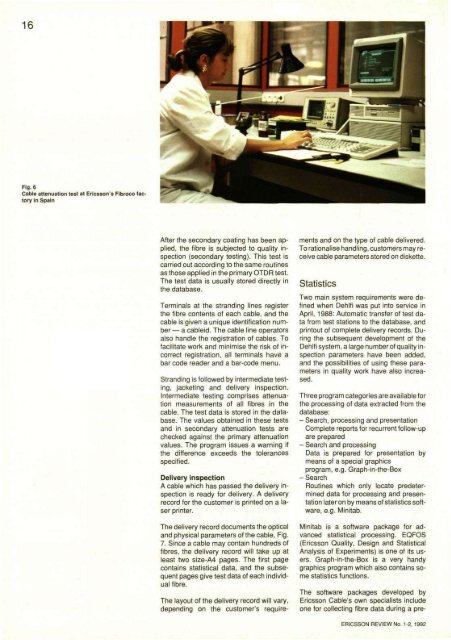Frame Relay - for Faster and More Efficient Data Communications ...
Frame Relay - for Faster and More Efficient Data Communications ...
Frame Relay - for Faster and More Efficient Data Communications ...
- No tags were found...
Create successful ePaper yourself
Turn your PDF publications into a flip-book with our unique Google optimized e-Paper software.
16Fig. 6Cable attenuation test at Ericsson's Fibroco factoryin SpainAfter the secondary coating has been applied,the fibre is subjected to quality inspection(secondary testing). This test iscarried out according to the same routinesas those applied in the primary OTDR test.The test data is usually stored directly inthe database.Terminals at the str<strong>and</strong>ing lines registerthe fibre contents of each cable, <strong>and</strong> thecable is given a unique identification number— a cableid. The cable line operatorsalso h<strong>and</strong>le the registration of cables. Tofacilitate work <strong>and</strong> minimise the risk of incorrectregistration, all terminals have abar code reader <strong>and</strong> a bar-code menu.Str<strong>and</strong>ing is followed by intermediate testing,jacketing <strong>and</strong> delivery inspection.Intermediate testing comprises attenuationmeasurements of all fibres in thecable. The test data is stored in the database.The values obtained in these tests<strong>and</strong> in secondary attenuation tests arechecked against the primary attenuationvalues. The program issues a warning ifthe difference exceeds the tolerancesspecified.Delivery inspectionA cable which has passed the delivery inspectionis ready <strong>for</strong> delivery. A deliveryrecord <strong>for</strong> the customer is printed on a laserprinter.The delivery record documents the optical<strong>and</strong> physical parameters of the cable, Fig.7. Since a cable may contain hundreds offibres, the delivery record will take up atleast two size-A4 pages. The first pagecontains statistical data, <strong>and</strong> the subsequentpages give test data of each individualfibre.The layout of the delivery record will vary,depending on the customer's requirements<strong>and</strong> on the type of cable delivered.To rationalise h<strong>and</strong>ling, customers may receivecable parameters stored on diskette.StatisticsTwo main system requirements were definedwhen Dehlfi was put into service inApril, 1988: Automatic transfer of test datafrom test stations to the database, <strong>and</strong>printout of complete delivery records. Duringthe subsequent development of theDehlfi system, a large number of quality inspectionparameters have been added,<strong>and</strong> the possibilities of using these parametersin quality work have also increased.Three program categories are available <strong>for</strong>the processing of data extracted from thedatabase:- Search, processing <strong>and</strong> presentationComplete reports <strong>for</strong> recurrent follow-upare prepared- Search <strong>and</strong> processing<strong>Data</strong> is prepared <strong>for</strong> presentation bymeans of a special graphicsprogram, e.g. Graph-in-the-Box- SearchRoutines which only locate predetermineddata <strong>for</strong> processing <strong>and</strong> presentationlater on by means of statistics software,e.g. Minitab.Minitab is a software package <strong>for</strong> advancedstatistical processing. EQFOS(Ericsson Quality, Design <strong>and</strong> StatisticalAnalysis of Experiments) is one of its users.Graph-in-the-Box is a very h<strong>and</strong>ygraphics program which also contains somestatistics functions.The software packages developed byEricsson Cable's own specialists includeone <strong>for</strong> collecting fibre data during a pre-ERICSSON REVIEW No. 1-2, 1992















